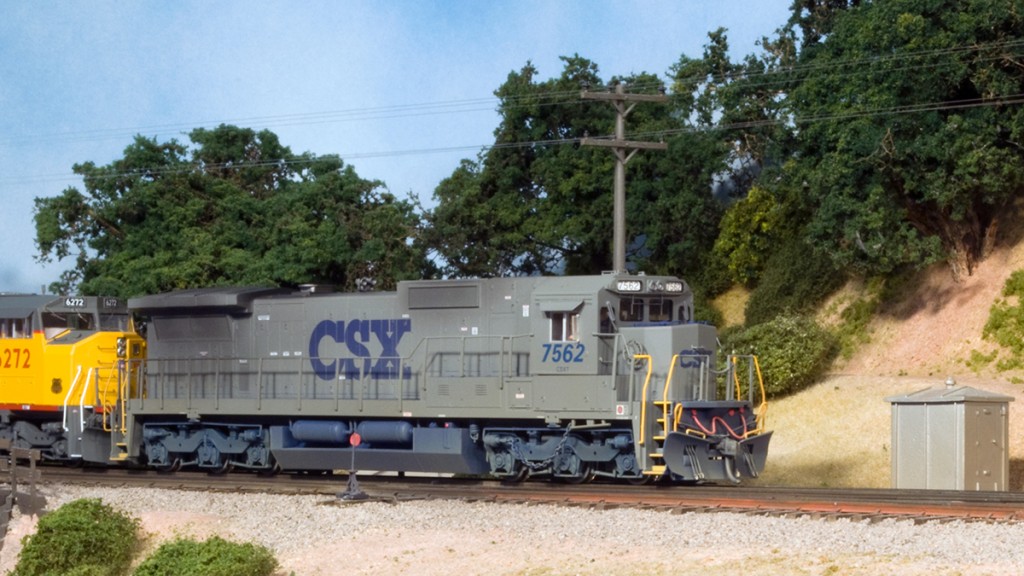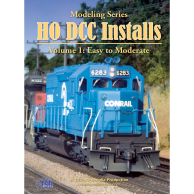
Atlas Master C40-8
Atlas C40-8, CSX 7562
Overview
CV Programming – ESU LokSound 3.5
Review
The Atlas C40-8 is a popular model of a common locomotive. Though like many Atlas offerings these were available with QSI sound already installed, I’m sure I’m not the only one who bought a non-sound unit and decided later that I wanted sound in it. Many of Atlas’s non-sound units like this one have sound-ready frames, making the job of installing a sound decoder a little easier.
Since this install was similar to others on the DVD, I focused on how I adapted one of the factory 30mm speaker mounts to fit a LokSound 28mm speaker.
CV Programming – ESU LokSound 3.5
Only common CVs or those that were changed from their default values are listed. Some settings reflect my personal preferences for speed matching and performance. The LokSound 3.5 has an outstanding BEMF implementation, and I left most of the BEMF-related CVs at their defaults.
| CV | Value (decimal) | Notes |
| 2 (start speed) | 1 | This controls the minimum voltage applied to the motor at speed step 1. |
| 3 (acceleration) | 28 | This controls how quickly the locomotive changes speed when accelerating. |
| 4 (deceleration) | 22 | This controls how quickly the locomotive changes speed when decelerating. |
| 5 (top speed) | 64 | This controls the maximum voltage applied to the motor at full throttle. |
| 6 (mid speed) | 34 | This controls the voltage applied to the motor at half throttle. |
| 17 (extended address) | 221 | For locomotives with a 4-digit address, CV 17 and 18 together determine the address. To be honest I never try to set these manually. My Digitrax system does all this automatically for me when I program a 4-digit address. |
| 18 (extended address) | 138 | see CV17 |
| 29 (configuration) | 38 | The setting of CV29 is complex. See your decoder instructions. Your DCC system may set CV29 for you when programming your locomotive’s address. If you need to modify CV29, it’s best to do it after setting the address. |
| 63 (volume) | 32 | This is the overall sound volume. |
| 121 (volume) | 64 | This is the horn sound volume. |
| 122 (volume) | 20 | This is the bell sound volume. |
| 123 (volume) | 20 | This is the auxiliary sound volume (prime mover, brake squeal, and everything else). |
| 172 (F5 button forward B) | 1 | Setting this variable to 1 prevents the locomotive from slowing down when dynamic brakes are turned on with the F5 button. |
| 175 (F5 button reverse B) | 1 | see CV172 |
Locomotive
This locomotive looks good and like most modern Atlas units, runs smoothly and quietly. Even though I mostly model the Southern Pacific and Santa Fe, I like these early CSX all-gray units. Having a couple of units from distant railroads adds variety to a diesel consist, is a good excuse to model something a little different, and on a modern railroad is completely plausible!
This was a factory-painted but unnumbered unit that I finished using Microscale decals. One thing I hadn’t considered when choosing a number for this unit was that at the time I had a Cotton Belt unit numbered 7652, which can be confusing. If I have a dyslexic moment I can sometimes dial up the wrong locomotive on the DCC controller! The Cotton Belt engine is one I intend to redo, so when it comes out of the shop it will likely have a new number.
Decoder
The LokSound 3.5 delivers outstanding performance and solid sound. I especially like the fact that the LokSounds don’t generally require much if any CV tweaking to achieve stellar performance. I have tried many brands of decoders and I have yet to find anything that will make a locomotive run better than a LokSound.
The sound quality of the LokSound 3.5 is largely dependent on the sound set that’s programmed into the decoder’s memory. Unfortunately the GE 7FDL-16 is not one of their better sound sets. If I ever have the chance to reprogram the decoder I might substitute the 7FDL-12 sound set, which sounds much better (even if it’s not really correct). The five-chime horn sounds good, though.
Note: On newer LokSound Select decoders, the GE prime mover sounds are much improved.
The LokSound 3.5 has the ability to load different or customized sound sets if you have a PC and the ESU LokSound Programmer hardware/software package. Thankfully, though, all of the features of the decoder aside from loading new sounds are accessible via CV programming.
Mac users need not feel left out. I have a Mac and run the LokSound Programmer software under Windows 7 using Parallels Desktop, an application that allows you to run PC software on the Mac!


Comments are closed.